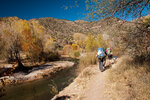Wind: mph,
Welcome to our new web site!
To give our readers a chance to experience all that our new website has to offer, we have made all content freely avaiable, through October 1, 2018.
During this time, print and digital subscribers will not need to log in to view our stories or e-editions.



Wilderness areas take us back to how the world looked before the advent of cars, roads and the many conveniences of civilization that we enjoy today. They are essential places where we can leave behind the stresses of modern life, unplug and renew our bodies and spirits.
But wilderness is much more than that, too. In addition to its value as a peaceful place for restoring balance in our lives, wilderness areas function as important refuges for plants and animals that have been displaced by human infrastructure. This loss of biodiversity – the variety of life in a particular habitat or ecosystem – is problematic because our knowledge of complex ecosystems is so limited. We don’t understand which species are crucial to the functioning of an area such as a forest or desert. Aldo Leopold, the father of wilderness areas, famously summarized our shortcomings when he said, “If the land mechanism as a whole is good then every part is good, whether we understand it or not… To keep every cog and wheel is the first precaution of intelligent tinkering.”
Species are going extinct due to habitat loss, among other reasons. Conservation biologists agree that we’re in the midst of the sixth mass extinction event in earth’s history. Unlike the previous five events, which were due to natural causes, the current one is entirely attributable to humanity’s success in populating all corners of the globe as well as the pollution that accompanies our societies. Because “extinction is forever,” as the bumper sticker says, preservation of wilderness areas as sanctuaries for imperiled plants and wildlife is more crucial than ever.
In addition to habitat loss, there is another overwhelming factor contributing to species extinctions. No discussion of wilderness, biodiversity loss and species extinction is complete without addressing the changing climate. As the American southwest gets hotter and drier, plants and animals alike are on the move, shifting higher in elevation or farther north (in the northern hemisphere) to find cooler, more suitable habitat. For some sensitive species to survive, they require available places of refuge, which are often found in wilderness areas free from human presence, infrastructure and interference.
Ultimately, the question we need to ask ourselves is: What kind of world do we wish to bequeath to our children and grandchildren? Are we satisfied to leave them a world mediated by electronic screens and populated with machines and artificial intelligence? Or do we want them to experience the earth we’ve known and loved, a world of beauty, majesty and mystery, complete with wild places, native plants and wildlife large and small?
If the answer to the second question is “yes,” we have plenty to celebrate in 2024, the centennial of the world’s first designated wilderness area, the Gila Wilderness.
Donna Stevens recently retired after 14 years as the executive director of the Upper Gila Watershed Alliance. She will never retire from her love of the Gila.